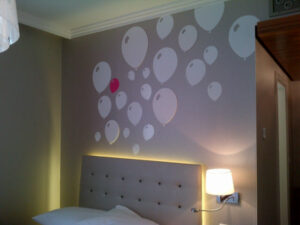A neo-Gothic church almost touches the back of the Schweitzerhof Hotel here in Lucerne, Switzerland. The Matheus Church is where Richard Wagner and Cosima von Bülow were married on August 25, 1870. They had to convert to Protestantism to marry there, as their divorces were not acknowledged in the faith of their birth, Catholicism.
Cosima’s wedding guests filled this historic hotel. It must have been quite a party as they celebrated the union between Wagner and this daughter of the celebrated pianist Franz Liszt. But this moment in time was just a single entry in the glittering life of this hotel.
It’s hard to believe the list of prominent people who have stayed at the Schweitzerhof. It seems one has to be inventing the coincidence of history, geography, and biography here: Mark Twain, Hans Christian Anderson, Lev Tolstoi, Leonard Bernstein, Queen Victoria, Kaiser Wilhelm II, Winston Churchill, Arturo Toscanini, Nellie Melba, Neil Armstrong, and . . . Nena!
That’s right: Nena. If you don’t know her, google her name, and I bet you’ll recognize her 1983 hit: 99 Luftballon (“Neun-und Neunzig Luftballon”). It’s the kind of song that, once you’ve heard it, won’t leave your head (see Earworms). Sometimes that’s a pleasant thing, and sometimes not.

It wasn’t pleasant to me when I first walked into Room 172, tired from a long day of sightseeing with my guests on the Smithsonian Journey’s Great European Tour. What was “99 Luftballon” doing playing on “my” TV as I opened the door? Furthermore, why was my room in this 19th-century hotel decorated with gauzy curtains and white plastic balloons climbing the wall above the headboard?
Well I was staying in Nena’s room. Yes, the Nena Room. The Schweitzerhof celebrates its history by decorating each room in the spirit of a famous person who once slept there.
Sometimes it’s a toss up (such as a Room 70 occupied in different decades by Zubin Mehta and Simon Rattle). But sometimes it’s quite clear who gets the nod: the Kaiser Wilhelm II Room, the Winston Churchill, Queen Victoria, and Queen Elizabeth II rooms. Each room is decorated accordingly to spirit of its famous person. The Lev Tolstoy room certainly doesn’t resemble Nena’s!
As a bonus, a beautiful coffee-table book called Where History Comes Alive lies open in each room to a page telling the story of that room’s super-star. My book was opened to a black and white photo of Nena and a description, in German and English, of how Nena stayed in Luceren in 2003 during her successful European Revival Tour .
At breakfast the next morning, we were all abuzz talking about our room’s famous personages. Some had historical figures—kings, queens, writers, but others were luxuriating in the rooms of B.B. King, Otis Grey, ZZ Top, Tracy Chapman, Jimmy Cliff, Natalie Cole, and Harry Belafonte. There was even Roger Moore’s room (James Bond), but, alas not Room 007. That was Richard Wagner’s room during a stay in summer 1859 where he worked on Tristan und Isolde.
My guests were definitely relating to “their” personages. After breakfast, we all wanted to go up and down the halls and ask: “Could I see your room?” “Could I see how the history was captured? How the décor expresses “your” person?” But we restrained ourselves.
Which brings me back to Nena. 99 Airballoons? Is that really me? Could I feel her spirit? Okay, it isn’t quite like staying in a room where the Beatles slept, but it was cool. I liked that her signature was blown up and embossed on the wall in the white and pastel bathroom.
Travel is always educational, but this was a new way to get a good education in the cultural history of Lucerne. I knew Lucerne was an artistic and cultural European hub. But to see it thorough the eyes of the Schweitzerhof—and of Nena, even—was a new educational delight and one I won’t forget any time soon.



